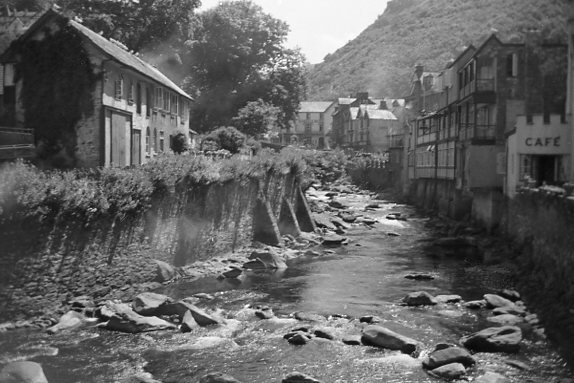To provide you with the best experience, cookies are used on this site. Find out more here.

To provide you with the best experience, cookies are used on this site. Find out more here.

Explore North Devon
Stay
What's On in North Devon

Welcome to the Itinerary Planner. Use this tool to build your own journey or choose from an exciting range of specially selected tours.
To build your own Itinerary, click  to add an item to your Itinerary basket.
to add an item to your Itinerary basket.

4th July 2017
.jpg)
Maggie Fink went to school in Lynmouth between 1940 and 1945 – during the Second World War.
In a special blog, she details her time living in the area…
In 1940, Badminton School was evacuated from Bristol to Lynmouth which was fortunate as an incendiary bomb later fell on the junior school destroying the roof.
I was five years old when I joined the school in Lynmouth. At first I was boarded with a family from London who had a daughter at the school. They were living in Bonneycott House at the time. I remember one night there was a dreadful storm and many fishing boats were destroyed.
However, I soon joined the school as a boarder.
To begin with both the senior and junior schools occupied the Tors Hotel. My first dormitory was room 12A which I shared with three other girls. Most of the junior classrooms were on the top floor though I remember doing “Music and Movement” in the basement and Art was in a conservatory with a eucalyptus tree growing in the centre of it.
The junior school was subsequently moved to The Manor House,we accessed the two schools by a zigzag path through the woods at the back of the Manor.
The Manor was an exciting old place for us youngsters,quite spooky in many ways. At night we could hear mice scuttling under the floorboards, we used to say “it was mice playing marbles”.
Occasionally,as a special treat, we would be taken into the cellars where there were lots of old candle stubs and old newspapers, we were told there was a smuggler’s passage down to the shore; true or not I don’t know but very thrilling for us anyway!
I remember it also as a very cold house,some of the girls developed really nasty chilblains which used to burst. The rooms were heated with coke stoves which had little Mica windows in their front doors,we were always getting into trouble by melting “Glitter Wax”sticks on them. These fires were looked after by a man named Jarvis, the caretaker, I presume ,who was also a member of the lifeboat crew.
We used to love it when the lifeboat was hauled out of it’s shed for a practice, we were allowed to help to pull it with ropes to the launch pad, it was a rowing boat and I’m afraid we always used to say that Jarvis was out of time with the others!
We had two playgrounds,one was kept mown for games like rounders, the other we called The Rough Patch, it had a very large Mulberry tree covered in fruit in the summer. We also had individual little garden plots where we grew radishes, lettuces, carrots and such like.
I do have so many happy memories of Lynmouth,waking in the morning to the screeching of gulls in the harbour and the wonderful sounds of the sea especially on stormy nights and of course the sound of the Lyn.
The old Colliers that anchored in the harbour,particularly the Enid who always seemed to be there. I remember too the journey from Minehead in “Charabancs”, many of us suffered from motion sickness and it wasn’t nice especially as we were all feeling somewhat homesick and tired after a long train journey.
There were exciting times when parents visited, then the drone of the Charabanc as Mr Priddle changed into low gear down Countisbury Hill was like music as we watched it arrive at the harbour through the big “Common Room”windows!
My parents used to stay in at the Lyndale Hotel owned by Mr and Mrs Bevan, very sadly destroyed in the terrible flood. I have some happy memories of birthday parties there too.
We certainly didn’t lack exercise, walking up Countisbury Hill and running along the bank we called “The Bun”, pond dipping in a pool on Wind Hill and often seeing wild horses, walking up the path behind the Pavilion to Lynton then along The North Walk to the Valley of the Rocks with the wild goats. Sometimes in the summer we would have picnics at sandy Lee Bay or rocky Wringcliffe Bay. One of my favourite walks was across the moors to Sillery Sands, climbing down a rusty old ladder to the beach or at low tide walking there along the shore. With it’s sandy beach and caves it was great for swimming and picnicking
We also had the run of Glen Gorge and in autumn we would collect sweet chestnuts that were there in profusion.
Walking to Watersmeet was a special treat, a visit to Mytleberry across a little wooden bridge which in those days also had a café, they made a wonderful dessert with myrtle berries and a very creamy custard, no cream allowed during the war!

In the summer we used to go to Cloud Farm in Brendan, camping, something we looked forward to for weeks! It was always great fun, cooking outside on fires we lit ourselves when it was our patrols turn to be cooks, singing songs round the campfire and best of all, swimming in beautiful pools in the Lyn.
Swimming in the summer term was in the big pool, we used to walk through the village in crocodile,wearing our swimming costumes.
Occasionally, the Commandos used to practice swimming in their full kit across the pool. Sadly I believe one of them drowned while attempting it.
From time to time, strong swimmers were allowed to swim in the sea in front of the Manor which was great especially if the sea was a bit rough. Funny how the cold water never seemed to bother us in those halcyon days!
Gym classes were held in the Pavilion, where we also staged plays, though the first play I was in was The Water Babies, which we performed in the Manor tennis court wearing only white Knickers!
Much grander productions, where we joined with the seniors, were staged at the Town Hall in Lynton, I was a fairy in Midsummers Nights Dream,and a wave in Sadko, about the Russian “Neptune”. We collected sheep’s wool from barbed wire on the moors, carded and dyed it for Sadko’s beard.
There was a shop in Lynmouth run by someone who we called Granny Slan selling sweets and cigarettes, and Pedders in Lynton, I still have a bone cup and saucer with Lynton and a stag on it which my parents bought there on one of the occasions they visited. When I was 9 my mother very sadly died and I remember the junior head mistress took me up the Cliff Railway to Lynton to Pedders and bought me a book called Fattypuffs
The Cliff Railway did,of course, play a big part in our lives, I think it cost 1 penny in those days!
We made a model of it in our “Project” class, the lift went up and down with syrup tins filled and emptied with water. I still remember the sound of the real thing emptying the water at the top!
On alternate Saturday’s some of us would take the cliff railway up to the Nancekivel stables to ride, often to the Valley of the Rocks or across the moors.
We could see the Welsh coast and the Mumbles, if it was too clear it was a sign it would be raining before the day’s end, and although we were well away from the bombing we were aware they were having raids over there. One night however, the siren sounded,we all had to get up and go down to the library where mattresses had been put on the floor, one of the teachers read Dr Doolittle to us. At the time it was all very exciting but I don’t think we were ever in much danger! I wonder now if it was in fact just a practice.
We had a fantastic Nature Room full of finds from our many rambles. Creatures collected from rock pools,crabs,fishes,anemones snails etc. Cadis and Ditiscus larvae from the Lyn fungi from the moors and Hollerday Hill. My continual love and interest in the natural world stems from those early days in Lynmouth for which I am so very grateful.
The last winter in Lynmouth was the first when it snowed. The village was completely cut off, we had a great time sledging down Countisbury Hill on tin tea trays from the kitchen
Everything was frozen, the staff, who I’m sure didn’t enjoy it as much as we did, collected water in buckets from the spring at the old bottling plant on the path to Watersmeet.
There were so many leaks in the roof and ceilings you could hear a constant drip,drip into the various containers in every room. I think we had seven bowls in our dorm!
At the end of the Spring Term in 1945 the school returned to Bristol.
As we left very early in the morning to catch our trains home from Minehead, a magnificent stag appeared standing high on Windhill almost as though it had come to say “Goodbye”.
I have made several visits to Lynmouth over the years. Of course the village has changed since the flood, but some of the old names remain and although it is a much busier place now with lots of visitors and tourists it still retains a very special magic for me.
I am delighted that every year my daughter takes her Year 6 children from Churchill School in Barnet, camping near Porlock and their favourite day is when they walk across the moors to Watersmeet and spend the day in Lynmouth and up the Cliff Railway to Lynton to see a film at the cinema and of course try to ring the nurses bell with a coin at the hospital before returning to Lynmouth for fish and chips!
I didn’t like school,too far from home at a very young age,but my experiences left me with an abiding love of nature for which I am so very grateful.
© Visit Devon Community Interest Company